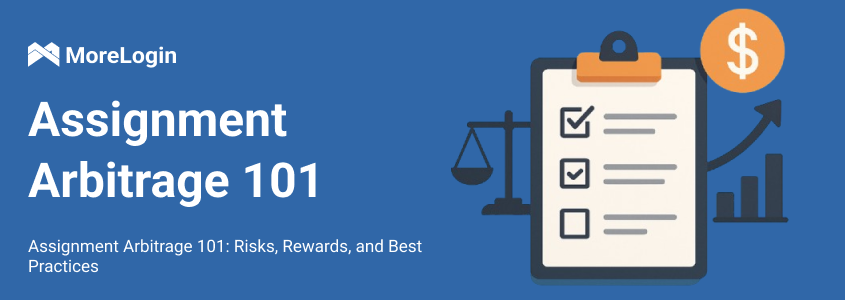
- Product

- Pricing
- Affiliate Program
- Use Cases
- Resource


How to find guaranteed arbitrage opportunities in the market? You can focus on assignment arbitrage in real estate investment, which is gradually becoming a widely noticed strategy. It allows investors to earn substantial profits through contract transfers without actually owning the property. This article will thoroughly explore the nature, advantages, risks, and practical methods of this strategy, providing you with a comprehensive guide.

(ALT: Assignment Arbitrage)
Assignment arbitrage refers to a specific process. In this process, an investor first signs a purchase contract with a seller. Then, the investor transfers the contract rights to a third-party buyer. This transfer occurs before the original transaction is officially completed. The investor profits from the price difference between the two transactions.
The core of this strategy lies in leveraging information asymmetry and price fluctuations to complete the arbitrage before the property ownership is transferred.
For example, an investor finds a second-hand home listed at 6 million yuan that has been on the market for three months. After research, they discover that the neighborhood's amenities are about to be upgraded. They negotiate with the urgent seller to sign a contract for 5.5 million yuan with a full-payment condition, paying a 300,000 yuan deposit. The contract explicitly includes an "assignment clause."
Two months later, as a new metro line plan is announced, property prices in the area rise significantly. The investor finds a new buyer through an agency at 5.8 million yuan, completes the assignment, and earns the price difference after deducting costs.
Unlike traditional property transactions, assignment arbitrage allows investors to profit without bearing the long-term risks and costs of property ownership.
This example highlights the key features of assignment arbitrage: leveraging the time value of contract rights to capture arbitrage opportunities amid market changes.
Successful execution requires precise focus on three critical points: selecting properties with appreciation potential, signing flexible contracts with assignment clauses, and establishing efficient buyer connections.
However, this strategy demands high accuracy in market trend judgment. If the market declines, investors may struggle to find buyers and lose their deposit.

The most significant advantage of assignment arbitrage is its low capital requirements and relatively controllable risk levels.
Unlike traditional real estate investments that demand large down payments and long-term loan commitments, investors only need to pay a contract deposit to secure a deal. This minimal financial barrier allows broader participation while limiting exposure to market downturns.
Assignment arbitrage offers significantly faster capital turnover compared to traditional property investments. Standard property transactions often take months to complete, whereas contract assignments can be finalized within weeks.
This accelerated process enhances capital efficiency, enabling investors to reinvest profits quickly. Additionally, since the strategy avoids actual ownership transfer, investors sidestep long-term costs such as property taxes and maintenance fees.
From a risk-reward perspective, assignment arbitrage strikes a balanced position. It is less risky than pure property speculation, as investors do not bear long-term market volatility risks.
Simultaneously, it offers higher profit potential than traditional rental income strategies. During market adjustments, undervalued quality properties often emerge, creating rare opportunities for savvy investors to capitalize on price disparities.
Assignment arbitrage fundamentally differs from other arbitrage forms. Spatial arbitrage relies on cross-market price gaps and faces dual pressures from exchange rate fluctuations and policy changes. Convertible bond arbitrage contends with interest rate volatility and credit risks.
In contrast, assignment arbitrage concentrates risk on a single property’s liquidity, with loss limits clearly defined by contract terms. This focused risk approach simplifies management and mitigation.
In terms of return certainty, assignment arbitrage outperforms strategies like dividend arbitrage and merger arbitrage. Dividend arbitrage suffers from high volatility due to ex-dividend price gaps, while merger arbitrage risks regulatory rejection.
Assignment arbitrage, however, typically completes within 2-8 weeks, with the primary risk being buyer default. This shorter timeframe and singular risk source result in significantly lower return volatility.
Assignment arbitrage is simple to operate. Other strategies, like convertible bond arbitrage, are complex. They require buying stocks and selling bonds at the same time. This needs advanced financial knowledge.
Assignment arbitrage only transfers contract rights. It is easy for all types of investors to understand. Anyone can learn and use this method.
By bypassing property ownership, assignment arbitrage avoids long-term costs such as property taxes and mortgage interest. Locking in contract rights transfers market volatility risks to end buyers, further reducing investor exposure.
The integration of digital tools, such as AI-driven market analysis platforms, enhances the sustainability of this arbitrage model. Its asset-light and fast-turnover nature solidifies its position as an excellent strategic choice for modern investors.
While assignment arbitrage offers attractive profit potential, investors must remain fully aware of its risks.
Legal compliance remains the primary challenge in assignment arbitrage. Not all purchase contracts allow free transfer of rights, as some developers include hidden restrictions. There have been cases where contracts stipulated a 15% transfer fee, significantly reducing investors' expected profits. Therefore, investors must engage professional lawyers to review assignment clauses, particularly verifying the seller's written consent in supplementary agreements. Using standardized contracts from housing authorities can substantially mitigate this risk, as they typically include clear assignment rules.
Market fluctuations directly impact arbitrage outcomes. When real estate markets suddenly shift, finding buyers willing to pay premiums becomes extremely difficult. For instance, investors facing regional price drops may see buyers withdraw, forcing them to sell contracts at 12% discounts. To manage this risk, implement safeguards like automatic termination clauses for market declines exceeding 10%. Tools like Rentana can help enforce 21-day exit mechanisms to avoid cyclical risks.
Operational risks often emerge from funding disruptions. If investors handle multiple assignments simultaneously and banks suddenly freeze loans, million-dollar funding gaps could lead to total deposit losses. Similarly, sellers concealing property seizures have triggered chain reactions of buyer defaults. Mitigate these risks by monitoring cash flows in real-time and setting account balance alerts.
Information asymmetry creates trust issues. Investors concealing property defects risk court-ordered compensation. The solution lies in transparency: mandate original condition reports in transfer agreements, and consider third-party escrow of 3% transaction amounts as good-faith deposits to enhance security.
After reviewing all risks of assignment arbitrage, we can see that success needs both finding opportunities and managing risks carefully. Using this strategy requires a systematic method with protection measures at each step. Here is the way to practice assignment arbitrage safely and effectively.
Contracts must explicitly allow assignments. This is the legal basis for all operations. Honest communication about arbitrage plans helps build trust. Contracts must explicitly allow assignments, as this forms the legal foundation for all operations. Transparent communication about arbitrage intentions helps establish trust with all parties involved. In markets like Miami or London, experienced real estate agencies often maintain networks of cash-strapped sellers who are ideal candidates for such arrangements. These institutions understand local regulations and can help you engage in legal arbitrage.
Real estate forums and professional networks like LinkedIn and real estate investment associations significantly improve match rates. These platforms connect investors with qualified buyers and sellers, facilitating faster and more reliable transactions. Improve match rates.
For investors looking to expand their reach across multiple marketing channels, understanding advertising arbitrage strategies can be particularly valuable when promoting property assignments. Tools like MoreLogin streamline multi-platform account management for efficient research and client outreach.
It allows you to securely manage multiple platform accounts simultaneously. This enables you to upload multiple listings at once to assist with buying and selling properties. With one-click file uploads, you can efficiently distribute property listings or marketing materials across different accounts.
This article has provided a complete understanding of assignment arbitrage, from core concepts to execution, benefits, to risk management. It offers investors a unique way to capitalize on market opportunities efficiently.
Use tools like Morelogin to eliminate the need to repeatedly log in and out of accounts, saving time and reducing operational errors. Its secure encryption ensures your account information remains protected during all operations. Even beginners can quickly learn to use it for efficient market research and client communication.
Success requires sharp market insight and robust risk controls, aided by smart tools like Morelogin to enhance speed and precision in arbitrage operations.